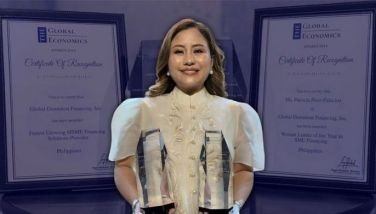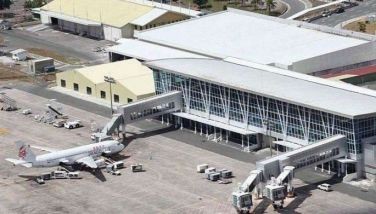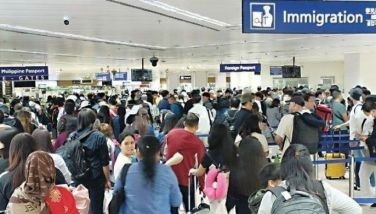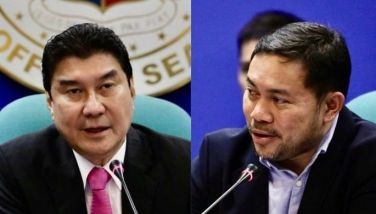No choice on MFN tariff rates
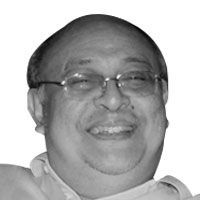
November 15, 2002 | 12:00am
There is nothing wrong with the government’s decision to backtrack from its unilateral decision during the Ramos years to bring down the MFN tariff rates to a maximum of five percent by 2004. It was not required of us to do that. The Ramos administration merely wanted to show the world how committed we are to globalization and free trade.
That would have been okay except for two things. The 1997 Asian financial crisis changed the business environment drastically. And secondly, neither the Ramos administration nor its successor administrations did anything much to prepare our local industries to survive in the tough new world. Neither safety nets for workers and companies nor a conscious effort to choose industries we will champion because of some competitive edge we have were implemented.
When Trade and Industry Secretary Manuel A. Roxas II said he was not bound by the commitments entered into by his predecessors on tariff cuts, he didn’t have much of a choice on what he should do. We simply couldn’t afford to keep our commitments ahead of time.
The Asean free trade commitments are challenging enough. Add MFN to that too. The most-favored nation (MFN) tariffs for non-ASEAN or under the World Trade Organization (WTO) are scheduled to go down to a minimum of five percent by 2004.
This year, there is the added complication to industrial competitiveness. The decline in tariff rates also has quite an impact on the worsening fiscal deficit problem. Customs collections have become an important source of revenue for the cash strapped government.
Hopefully, the government will use whatever little time it now regained to do its homework. The task of making ourselves fully adjusted to globalization should now be undertaken a little more vigorously. We need an information campaign to let our entrepreneurs know what industries should be given up and what industries should be developed.
For instance, we keep on talking about our supposed competitive position in IT. But what are we doing to catch up with India, the obvious front runner among the third world countries in this area. We have heard the speeches, read the press releases and seen the photo ops. The time has come to move on with more concrete things, with government and private sector leaders working together.
Actually, Mar and Ate Glo’s economic managers need not prepare another Powerpoint presentation directed at investors. I understand the President’s own council of business advisers composed of top executives from some of the world’s largest corporations already told her the problems that hinder us. We just have to start working to show that we finally mean business.
A doctor, a student of my father many years ago at UST, e-mailed this reaction to my column last Friday which reported a comment on defensive medicine made by some doctors in a TV talk show panel hosted by Ces Drilon.
Defensive medicine will increase healthcare costs? How much would it cost to do an ultrasound study, BEFORE a ceasarian section or gall bladder resection? The cost of a second opinion is a consultation fee (free in charity and government hospitals), which in the Philippines amount to less than P300.
If a surgeon "forgot" a sponge in a patient’s body, who pays for the extra hospitalization? In the Philippines, the patient does, though he can "ask for a discount". Another facet to the debate, which is totally ignored is: WHO PAYS THE PREMIUMS? In the USA, the government pays for the MD’s in public health, the university/hospitals pay for MD’s on salary, i.e. only private physicians on fee-for-service pay individually.
Impact: GROUP COVERAGE CAN BE VERY CHEAP. Plus, the partnership between the MD’s and the hospitals will be raised to a different level. Hospitals as "employers", will now have an incentive to police their "employees" and who knows, perhaps we will see more QA’s and UR’s (which by the way DO NOT COST THE PATIENT EXTRA - MANY TIMES THEY ACTUALLY CUT PATIENT COSTS, vis-a-vis non-indicated procedures) in hospitals.
The point is NOT ALL DEFENSIVE MEDICINE COSTS. But here’s a little tidbit for the med establishment, just to prove, that l am not really against them – MMLIC, the largest med insurance carrier in New York, is a subsidiary of the New York Medical Society! l hear, it earns a lot. New York is not alone in this.
Last week, two Filipinos were basking in glory abroad, enjoying a moment they have found elusive at home. Ate Glo, from all accounts, was impressive in both the Apec Summit in Mexico and the Asean Summit in Cambodia. Dr. Lucio Tan, on the other hand, was practically adopted as Guam’s native son for his humanitarian services to the island and his investments.
Their experiences last week are typical for many Pinoys who find their place in the sun abroad. There are those who would say that the difficulty people like them experience in developing a good image at home is nothing more than the crab mentality at work here. Maybe, we have an allergy to anyone who succeeds in what they do by efficiently playing by the established rules of the game, whether it is politics or business.
Success, as any lotto winner will tell you, brings with it its own seeds of problems and frustrations. Ate Glo’s success as a politician is her biggest handicap. Dr. Lucio’s phenomenal ability in making money is his Achilles heel.
It isn’t that we are naturally envious of success or enjoy putting down people. We have just become so jaded through years of muddling through. We can’t believe anyone of us could be that good.
Well, the Pinoys are good, no doubt about that. We are world class, if we set our minds to achieve anything. The fact that Pinoys are the workers and professionals of choice abroad should clear any lingering insecurity about how good we are.
Expect Dr. Ernie E to find something funny all the time. When we wrote about the need for second opinion before following your doctor’s kinda drastic recommendation, Dr. Ernie E sent me this joke from his collection.
A guy went for his annual follow-up physical. When the examining doctor did the rectal exam part, the patient felt more uncomfortable than usual. Realizing that the doctor was using two fingers this time around, he wondered aloud why the doctor is now using two fingers instead of one, like the first time.
Whereupon the doctor replied nonchalantly, "Second opinion!"
(Boo Chanco’s e-mail address is [email protected])
That would have been okay except for two things. The 1997 Asian financial crisis changed the business environment drastically. And secondly, neither the Ramos administration nor its successor administrations did anything much to prepare our local industries to survive in the tough new world. Neither safety nets for workers and companies nor a conscious effort to choose industries we will champion because of some competitive edge we have were implemented.
When Trade and Industry Secretary Manuel A. Roxas II said he was not bound by the commitments entered into by his predecessors on tariff cuts, he didn’t have much of a choice on what he should do. We simply couldn’t afford to keep our commitments ahead of time.
The Asean free trade commitments are challenging enough. Add MFN to that too. The most-favored nation (MFN) tariffs for non-ASEAN or under the World Trade Organization (WTO) are scheduled to go down to a minimum of five percent by 2004.
This year, there is the added complication to industrial competitiveness. The decline in tariff rates also has quite an impact on the worsening fiscal deficit problem. Customs collections have become an important source of revenue for the cash strapped government.
Hopefully, the government will use whatever little time it now regained to do its homework. The task of making ourselves fully adjusted to globalization should now be undertaken a little more vigorously. We need an information campaign to let our entrepreneurs know what industries should be given up and what industries should be developed.
For instance, we keep on talking about our supposed competitive position in IT. But what are we doing to catch up with India, the obvious front runner among the third world countries in this area. We have heard the speeches, read the press releases and seen the photo ops. The time has come to move on with more concrete things, with government and private sector leaders working together.
Actually, Mar and Ate Glo’s economic managers need not prepare another Powerpoint presentation directed at investors. I understand the President’s own council of business advisers composed of top executives from some of the world’s largest corporations already told her the problems that hinder us. We just have to start working to show that we finally mean business.
Defensive medicine will increase healthcare costs? How much would it cost to do an ultrasound study, BEFORE a ceasarian section or gall bladder resection? The cost of a second opinion is a consultation fee (free in charity and government hospitals), which in the Philippines amount to less than P300.
If a surgeon "forgot" a sponge in a patient’s body, who pays for the extra hospitalization? In the Philippines, the patient does, though he can "ask for a discount". Another facet to the debate, which is totally ignored is: WHO PAYS THE PREMIUMS? In the USA, the government pays for the MD’s in public health, the university/hospitals pay for MD’s on salary, i.e. only private physicians on fee-for-service pay individually.
Impact: GROUP COVERAGE CAN BE VERY CHEAP. Plus, the partnership between the MD’s and the hospitals will be raised to a different level. Hospitals as "employers", will now have an incentive to police their "employees" and who knows, perhaps we will see more QA’s and UR’s (which by the way DO NOT COST THE PATIENT EXTRA - MANY TIMES THEY ACTUALLY CUT PATIENT COSTS, vis-a-vis non-indicated procedures) in hospitals.
The point is NOT ALL DEFENSIVE MEDICINE COSTS. But here’s a little tidbit for the med establishment, just to prove, that l am not really against them – MMLIC, the largest med insurance carrier in New York, is a subsidiary of the New York Medical Society! l hear, it earns a lot. New York is not alone in this.
Their experiences last week are typical for many Pinoys who find their place in the sun abroad. There are those who would say that the difficulty people like them experience in developing a good image at home is nothing more than the crab mentality at work here. Maybe, we have an allergy to anyone who succeeds in what they do by efficiently playing by the established rules of the game, whether it is politics or business.
Success, as any lotto winner will tell you, brings with it its own seeds of problems and frustrations. Ate Glo’s success as a politician is her biggest handicap. Dr. Lucio’s phenomenal ability in making money is his Achilles heel.
It isn’t that we are naturally envious of success or enjoy putting down people. We have just become so jaded through years of muddling through. We can’t believe anyone of us could be that good.
Well, the Pinoys are good, no doubt about that. We are world class, if we set our minds to achieve anything. The fact that Pinoys are the workers and professionals of choice abroad should clear any lingering insecurity about how good we are.
A guy went for his annual follow-up physical. When the examining doctor did the rectal exam part, the patient felt more uncomfortable than usual. Realizing that the doctor was using two fingers this time around, he wondered aloud why the doctor is now using two fingers instead of one, like the first time.
Whereupon the doctor replied nonchalantly, "Second opinion!"
(Boo Chanco’s e-mail address is [email protected])
BrandSpace Articles
<
>
- Latest
- Trending
Trending
Latest
Trending
Latest
Recommended













